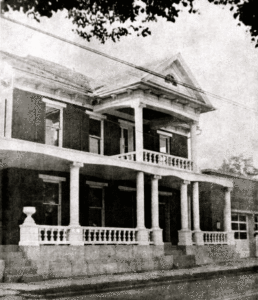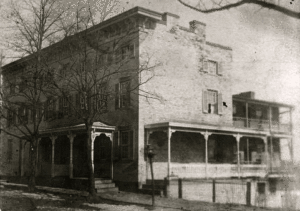
The Present Past
The Two Doc Birelys
by “My Father’s Son” A graduate of the University of Maryland Medical School, Morris Alleman Birely set up a medical practice in Thurmont in 1894. Birely’s lengthy career also recognized him as the longtime physician to the Western Maryland Railway Company and Emmitsburg’s St. Joseph College. Morris A. and wife Bertha Bushey Birely purchased the family home of Leonard R. Waesche at 19 North Church Street in April of 1907. Waesche owned the home, a few doors away and across the street from his mother’s residence, for twenty-five years. Still echoed today in local stories and accounts, “Doc Birely” was the name of health and medicine in our northern region between 1894 and 1961, the association split between Morris A. (in practice fifty-three years), and later his son, Morris F. Birely, who followed his father as a practitioner beginning in 1944. The Birely home, built in 1874 by Charles E. Cassell, stood between St. John’s Lutheran Church and the former Town Hall, which also acted as an engine house for the Fire Company. The all-brick home featured a wrap-around porch overlooking the street, a semi-circular window framed by a turn-gable above the front balcony, and a turreted bay-window exaggerating its southwest corner (seldom visible in photographs, but occasionally appearing in the background of views taken of neighboring St. John’s Church). Cassell had his home constructed by brothers Leonard R. and James T. Waesche, who built many homes in town during this time. Most indicative that the Birely’s home was built by the pair is the distinctive aforementioned front porch. Formed of concrete, the square paneled pedestals, shallow spandrel arches, and circular columns fit between, in addition to stylized cast balustrades with urn-planter terminations, make this porch the archetype of what became a Waesche signature, with variations later displayed on Waesche projects like their 108 Park Lane and 11 S. Carroll Street (soon to be demolished) homes, as well as the 1913 remodel of the former High School, once located between 210 and 302 E. Main Street, operated by Waesche as the Maple Inn. Waesche Bros. & Co. was started in 1871, advertising: Sash, doors, blinds, balusters & balustrades, newel posts, handrails, wooden mantles, moldings, brackets, circular work, washboards, casings, and all manufactured building materials. “We are prepared to build at home or abroad, from foundation to top complete, and finish in the best workmanline manner, HOUSES, on the most reasonable terms.” At least forty-six homes were erected before 1883. Born Catharine Cassell, Leonard Waesche’s mother was sister to Abraham Cassell, Charles E. Cassell’s father. L. R. Waesche and wife, Mary Martha “Molly” Foreman, were conveyed the Cassell home in 1882 by Charles (Leonard’s first cousin) and wife. Matters further entwined, this conveyance likewise transferred Mary M. Waesche the home of her sister, Julia C. Foreman Cassell; the sisters having each married one of the cousins. This double-jointed relation made the collective fourteen children (eight Waesche, six Cassell) both first and second cousins simultaneously, and each father’s nieces and nephews also his first-cousins once-removed! The final four of the Waesche brood were born to the number 19 address, U.S.C.G. Rear Admiral Russell Randolph Waesche first in 1886, and Clinton Foreman Waesche last in 1895. The 1900s approaching, L.R. Waesche again became involved in the Catoctin Iron Works and left North Church Street for Catoctin Manor. Waesche retained the town residence until the family instead returned from the Furnace District to their newly acquired Park Lane property, Dr. Birely purchasing their previous home at this time. The home’s exterior would always remain unaltered, excepting the exchange of a window for a second front entrance leading to Dr. Birely’s office. The same day Dr. Birely purchased his home, he, too, acquired North Church’s opposite structure, numbered 16, from Colonel John R. Rouzer. A masonry form of an early duplex, this structure was made of two nearly symmetrical “L”-shaped units mirrored together, forming an overall “T”-shaped footprint divided vertically into two units between the adjacent front doorways. A rear-sloping shed roof allows this surviving building to appear from the front as flat-roofed and three stories with an elaborate entablature, crowning the edifice to deter rainwater necessitated by the roof’s eave-less design. The left portion of Rouzer’s building contained son Morris F. Birely’s practice and residence with wife Louise (Carter) Birely, son Carter, and step-daughter Sandra. A living room, bedrooms, and bathroom were arranged on the second floor, while the dining room and kitchen remained situated around the doctor’s office on the entry level. The topmost level was a playroom for young Carter. The right-hand division was long rented to the Liebert Weddle family. The senior Morris passed of a cerebral hemorrhage at home in 1947, after the game-six radio broadcast of the World Series. Wife Bertha Birely survived until 1957, at which time Morris F. inherited his parent’s estate, including the North Church properties. 1950 had replaced the neighboring Town Hall north of the remaining Morris’s parent’s home with a modern Fire-house separated by a narrow alleyway. Morris and wife Louise never relocated to his childhood home but continued to reside above his practice, instead renting 19 to Morris’s cousin’s son, Samuel. Come 1960, divorce trials for Morris F. and Louise Birely were underway. Witnesses like Mrs. Samuel L. Birely of 19 N. Church Street appeared in court. The majority testified to a seemingly normal union between the Birelys, though some mention was made of marks or bruising upon Mrs. Birely, and recollections of allusive comments made by the doctor’s wife concerning her marriage. Proceedings also suggested excessive alcohol consumption by Dr. Birely on occasion and supposed resentment towards his step-daughter, which Mrs. Birely claimed her husband addressed by enrolling her daughter in private schools and limiting visits to the holidays. The Frederick News made mention of the strange distance also kept by the doctor from his own son, the boy’s discomfort at one point making him glad to “go to camp” to escape the house. Allegations of verbal abuse, recklessness involving automobiles, and telephone harassment after Louise relocated to Baltimore were also recorded. More particular to the case was the question of multiple diamond rings Louise claims were given to her by her husband’s late-mother near her death, which Mr. Birely demanded be returned. Morris F. Birely was found dead in bed at the age of fifty-seven in November 1961. The Frederick News listed him and Louise as “separated.” Headlines following Birely’s death focused on the late doctor’s estate, in excess of a quarter of a million dollars (roughly equivalent to $1.9 million today), left solely to fifteen-year-old Carter Birely. On July 26, 1962, the Birely house along with the Rouzer building it faced were purchased at public sale by the Guardian Hose Company for $15,200. Morris F. Birely’s practice and residence was resold to the Hammaker Development Company and has long been utilized as apartments. The 19 N. Church St. Cassell/Waesche/Birely home was razed in order to create a parking lot for Guardian Hose Company 10. Further expanded today, the unattractively utilitarian exorbitance of yet another new Guardian Hose building (c. 2007) lies crammed in the void, once partially filled by the disappearing quality of early American architecture exhibited in Thurmont by the Birely house for eighty-eight years.
19 N. Church Street: The Birely Home, c. 1874, as it stood in 1962 prior to expansion of the Guardian Hose Company (also seen in the frame).

16 N. Church Street: The home and practice of the Junior Dr. Morris Birely and family, built by John R. Rouzer in 1890.
Photos Courtesy of John Kinnaird’s ThurmontImages.com